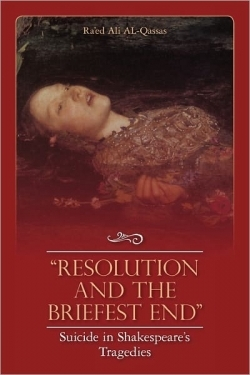"Resolution and the Briefest End"
Suicide in Shakespeare's Tragedies
It is fitting that the title of a book that examines the suicide motif in Shakespeare’s works is inspired by Act 4 Scene XV of Shakespeare’s tragedy Antony and Cleopatra. In this scene, Mark Antony has died in Cleopatra’s arms after mortally wounding himself. Cleopatra beseeches the women around her, as she makes the declaration that death is an eventuality for everyone, a forecast that she will take her own life: “Ah, women, women! Come; we have no friend. But resolution and the briefest end.”
Antony and Cleopatra, however, isn’t examined in “Resolution and the Briefest End“ Suicide in Shakespeare’s Tragedies. Instead, author Ra’ed Ali AL-Qassas concentrates on six of Shakespeare’s other tragedies, Hamlet, Macbeth, King Lear, Timon of Athens, Othello, and Julius Caesar. Before going into a detailed analyses of the suicides in each tragedy, the author explains how Shakespeare created appealing and powerful dramatic characters who contemplated the spirituality and psychological depths of the human condition through the duality of the Christian belief that suicide is a mortal sin and the contrasting Greco-Roman teachings that embrace suicide as a noble way of controlling one’s destiny. Shakespeare knew that both schools of thought would be accepted by the Renaissance audience, “…the Renaissance man was able to accept both without feeling much contradiction because he had two distinct worlds with different sets of rules: The real world of men in which Christianity reigned and condemned suicide, and the fictitious world of the theater in which the classical and literary productions of the period welcomed noble, heroic suicides.” Audiences then and today understand that when Shakespeare’s characters take their own lives, they arbitrate their own destiny and transform from human heroes and heroines to beings that are godlike, their stories eternally branded in our psyches. This is why Shakespeare’s work is timeless.
Written for academics, the well-educated, and Shakespeare fans, the book by AL-Qassas is devoid of the dry and pretentious drone found in many works of literary criticism. The author’s descriptions of Shakespeare’s characters and his explanations for their actions plumb the depths of their emotional, intellectual, and psychological layers. AL-Qassas dares to add an extra breath to Shakespeare’s already larger-than-life creations by putting their actions and the repercussions of those actions under the scrutiny of not only Renaissance citizenry but also twenty-first century mankind. In doing this, the reader discovers that Shakespeare’s characters—their soliloquies, lamentations, heroism, villainy, and stupidity—reflect the human condition. They reflect one’s own strengths, weaknesses, triumphs, and failures. Indeed, his characters are a reminder that the darker side of human nature is the only constant in an evolving universe.
Reviewed by
Lee Gooden
Disclosure: This article is not an endorsement, but a review. The publisher of this book provided free copies of the book and paid a small fee to have their book reviewed by a professional reviewer. Foreword Reviews and Clarion Reviews make no guarantee that the publisher will receive a positive review. Foreword Magazine, Inc. is disclosing this in accordance with the Federal Trade Commission’s 16 CFR, Part 255.

